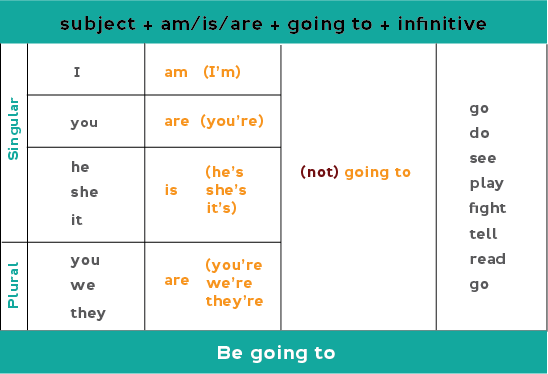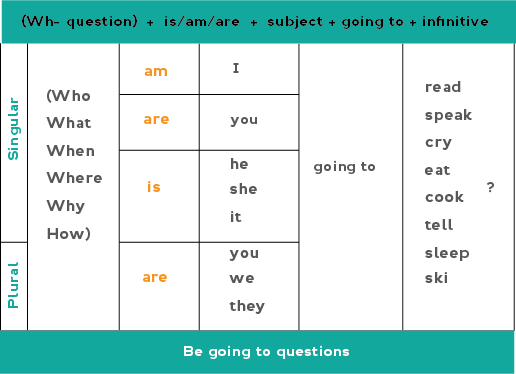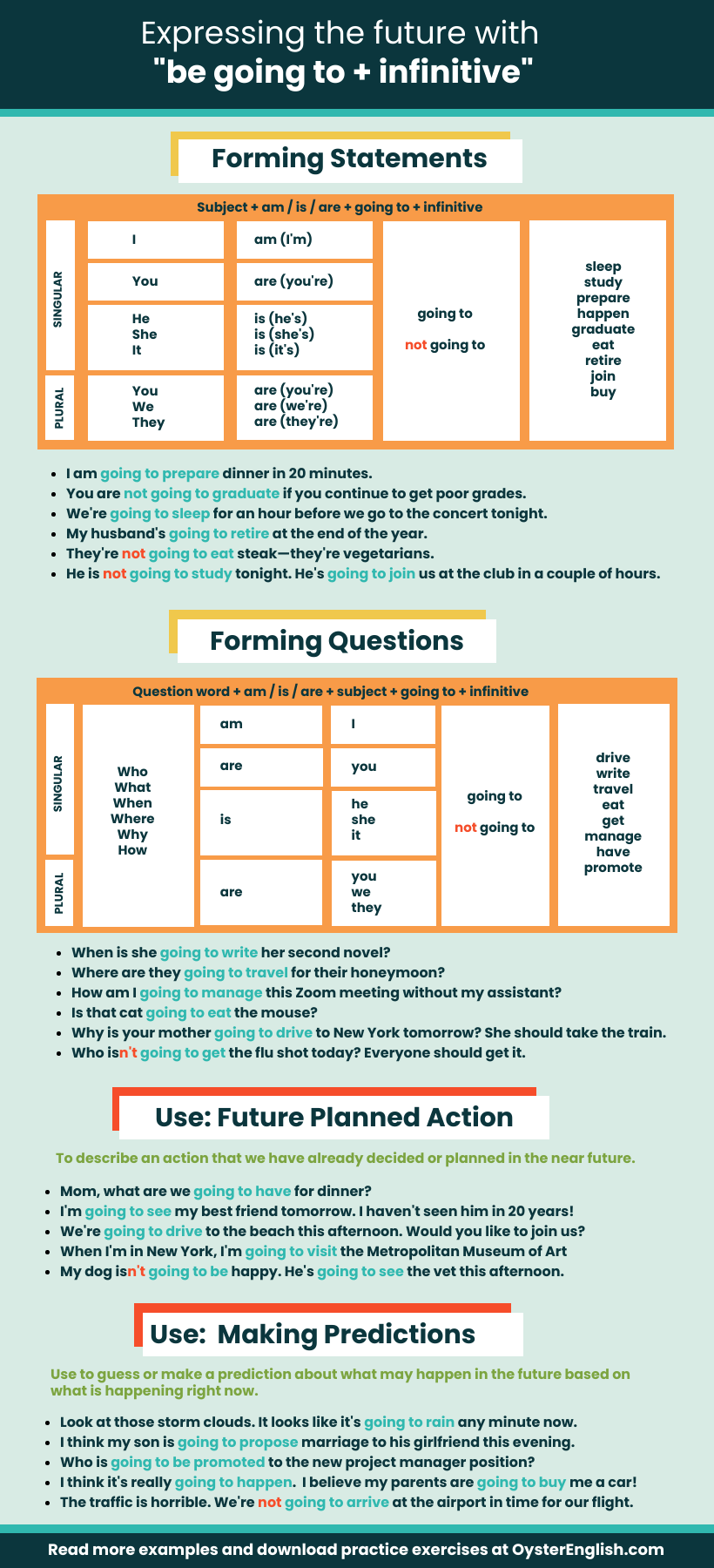"Be going to" Form and Usage
We can express the future with "be going to + infinitive." In this section, we'll look at how to form the future simple using "going to" as well as when to use this tense.
To learn the differences between "be going to" and "will/shall" click here.
The infographic provides a good summary of "be going to" but let's take a closer look at the form and uses with more explanation and examples.
[Click here to download a PDF of this infographic. When printing, in the "fit" section, select "shrink to fit" to scale the entire infographic to fit on one page]
"Be going to" statements (affirmative and negative)
Forming this tense is rather simple:
Subject pronoun + the verb "be" + "going to/not going to" and the infinitive of the verb:

We can use contractions (e.g., I'm, he's) by combining the subject pronoun (e.g., I, he) with the verb "be". We can also add "not" in front of "going to" to form the negative.
Here are some examples to make sure this is clear:
- I am going to see a play tonight. (I'm going to see a play tonight.)
- It's late so I don't think he's going to do his homework tonight.
- Look at those clouds. It's going to rain soon.
- We're not going to see my mother this summer.
- My favorite team is going to play tomorrow evening.
- He's going to tell his boss he's resigning today.
- I'm afraid they're not going to read the whole report.
Again, it's okay to contract the subject pronoun and verb "be" or not contract them:
- It's going to rain soon.
- It is going to rain soon.
Remember, contractions are common in spoken and informal English.
Pronunciation Note: When we speak, we also often say "gonna" instead of "going to." We shorten and push the words together so that we can speak more quickly.
For example, I'm going to play tennis this afternoon sounds like: Aym gonna play tennis...
Questions using "be going to" form

To form of questions, we invert the subject (e.g, I, you) and "is/am/are." If we use a wh- question word, we insert it at the beginning of the sentence.
Examples:
- Who is going to read the next paragraph?
- Are you going to speak at the conference?
- Is he going to cry again today?
- What is she going to cook for dinner?
- Are they going to sleep all day?
- When are we going to eat lunch?
- Is he going to tell us what to study for the test?
- Where is your brother going to sleep when he visits you?
- Aren't they going to fly to their daughter's wedding in Los Angeles?
Uses of "be going to"
There are two main uses of "be going to" + the infinitive.
Future planned action
We can use "going to" to describe a planned action that will happen in the near future. In this situation, we've already decided or planned this action.
- I'm really tired so I'm going to sleep early tonight.
- Next week I'm going to start a new diet.
- My daughter's going to study law at college next year.
- He's not going to speak at the conference.
- Are you going to come to my party tomorrow?
- What are you going to wear to the dance?
- Let's also get some beer. My boyfriend's not going to drink wine.
Note: We can also use the present continuous to talk about planned future arrangements. They are very close in meaning so it's possible to use either:
- Next week I'm going to New York on business. (present continuous)
- Next week I'm going to go to New York on business. (be going to)
- Are you attending the lecture this afternoon? (present continuous)
- Are you going to attend the lecture this afternoon? (be going to)
Sometimes learners wonder if the verb "go" can be used with "be going to" because it seems strange to repeat "go" twice. Yes, it is correct to use either form with the verb "go."
- We are going to go to Japan to see the Olympic Games.
- We are going to Japan to see the Olympic Games.
The only real difference is that using the present continuous (going to) is shorter than saying "going to go."
Prediction based on present situation
We can use "going to" to express a prediction (a guess or estimate) about what may happen in the future based on what is happening right now.
Examples:
- It's 7 PM and the sun is going down. It's going to be dark soon.
- Look at the line. It's going to take a long time to get a table.
- The sun is coming out. It's going to be a beautiful day after all.
- Only five people signed up? My boss is not going to speak to such a small audience.
- I got a D on my exam. My parents are going to kill me.
- Keep up the good work and you're going to get a raise.
Expressing the future
As we've learned here, we use "be going to + infinitive" to describe future planned actions or to predict future actions or events.
Sometimes, it confuses learners that we can express the future in English in these ways:
- be going to
- present continuous
- present simple
- future simple
As noted above, "be going to" and the present continuous have basically the same meaning when talking about the future. However, there are differences when using the future simple (will/shall) and present simple to describe the future.
I recommend you read this page to better understand these differences.
- Home Page ›
- Main Grammar Page ›
- Using "Be going to"

